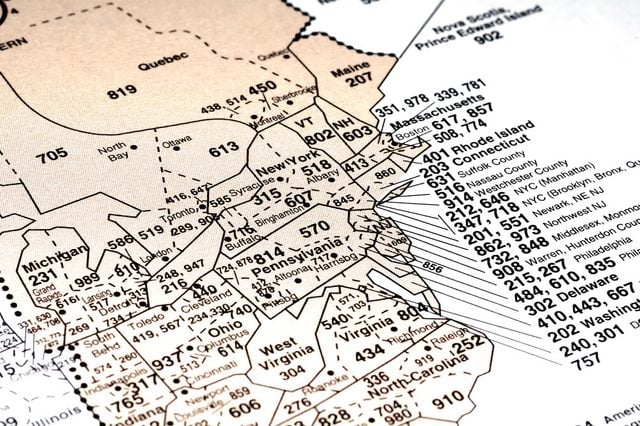Here’s the Real Reason Why Area Codes Make No Geographical Sense
Updated: Jan. 05, 2018
Let’s just say geography was the last thing on the telephone company’s mind.
 Have you ever noticed how area codes aren’t laid out as neatly numerically as, say, the U.S. Interstate Highway system? For the most part, interstate highway numbers tend to grow higher in value as you travel east or south, but if you move from New York to Vermont your area code may change from 518 to 802. This random jump of numbers is because geography didn’t determine area code designations—population density did.
Have you ever noticed how area codes aren’t laid out as neatly numerically as, say, the U.S. Interstate Highway system? For the most part, interstate highway numbers tend to grow higher in value as you travel east or south, but if you move from New York to Vermont your area code may change from 518 to 802. This random jump of numbers is because geography didn’t determine area code designations—population density did.
The Bell System, formerly a system of companies led by the Bell Telephone Company, created the first area codes back in the 1940s called the North American Numbering Plan. These designated area codes helped automate telephone calls to anywhere across the country without the use of a human operator to connect you. Area codes helped redesign the antiquated phone system because there weren’t enough human operators to fulfill the needs of the growing population. (Here’s why you should never say yes to this four-word automated phone phrase next time you take a call.)
And so, the Bell System designated 86 separate Numbering Plan Areas throughout North America. By 1947, the majority of the states had one area code with a select few (such as California) getting more due to the state’s size and population, according to telephone researcher Linc Madison. Each state area code was given either a “0” or a “1” for its second digit. States with single area codes received a “0” and states with multiple area codes got a “1.” By leaving out numbers higher than one on the second digit, a plethora of other area codes would be available in the future to compensate for population growth spurts.
States with the densest populations or prominent cities were given the most popular codes and easiest to dial on the old-fashioned analog dial phones. For example, California initially got area codes 916, 415, and 213 while the city of Chicago got 312. Of course, there are quirks to the phone system such as setting aside special number combinations for specific purposes like 37X and 96X, which are reserved for “unanticipated purposes where it may be important to have a full range of 10 contiguous codes available.”
Today, if you look at a map of area codes in the United States the North American Numbering Plan isn’t as clean and simple as it once was in its early days. An area code no longer represents one state in its entirety, but instead individual regions within that state. And a growing population isn’t just to blame for the expanding number of area codes—technology is too. The amount of available area code combinations quickly diminished as our modes of communication grew to using faxes, pagers, modems, and cell phones. Simply put, a single area code just wasn’t enough to fit the number of people and tech devices. In 1997, Maryland had to switch to 10-digit numbers for local calls and cities like New York City have multiple area codes to cover small areas. The overall explanation for why an area code is used over another nowadays is because its available.
(And if you ever get a phone call from a number with these area codes, do not pick up! It’s a scam!)
[Source: Atlas Obscura]